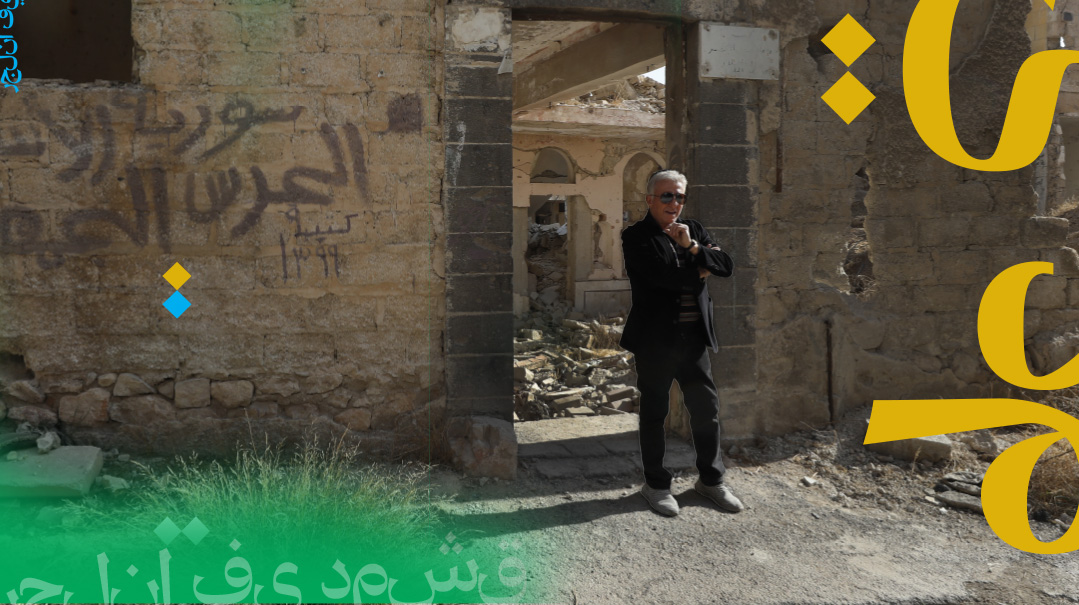Land of Faith

Snapshots of a fallow land and its faithful people
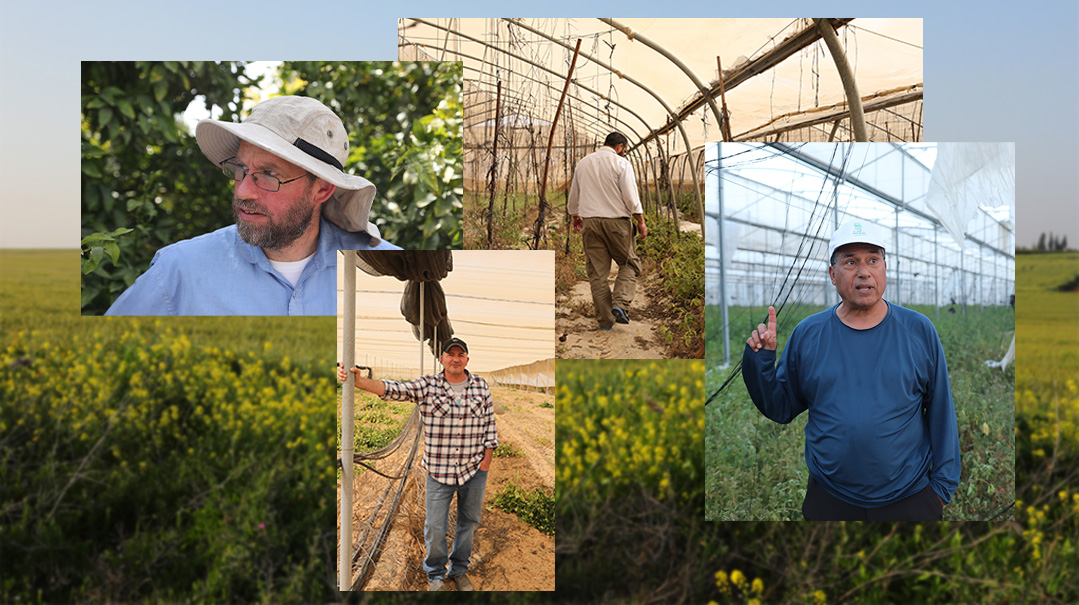
Photos: Menachem Kalish
Come back in two months’ time, and the northern Negev will be a burning, sun-baked expanse.
The heat will reflect off the brown earth the way asphalt shimmers on a hot afternoon, and the sky overhead will be a fierce gray.
Driving down Route 40 to the Egypt-Gaza border on a spring morning, the desert hasn’t yet moved in; all around is soft, undulating green. The knowledge that the vistas will disappear like a mirage is what gives them their fragile beauty.
As Be’er Sheva and Nachal Gerar flash past, like a tour of Avraham Avinu’s life, it’s easy to get lyrical about the scenery.
But under the surface of this postcard landscape, something truly poetic is happening.
The land is at rest.
For the first time in thousands of years, more than half of the Jewish-owned farmland in the country is observing shemittah. Not the parcels of land of a century ago when the proverbial swamps were drained. Not even the 300,000 dunams of arable land that lay empty seven years ago.
Despite the ongoing economic turmoil, over 600,000 dunams of prime agricultural real estate, which in normal years ship Grade A produce around the world, are lying fallow.
And like the onions that grow in this part of the world, there’s another layer to the story — the farmers themselves.
Something is stirring in the soul of this holy land. Farmers of all types — religious and secular — are embracing the hardest mitzvah there can be for a man of the earth.
In unprecedented numbers, they’re throwing financial caution to the wind, parking their tractors and letting their greenhouses grow wild.
Those men and their convictions have brought me to this corner of the Negev today, where people live under the surveillance blimps of the IDF, and the thump of mortar rounds going off in Gaza.
I’m here to discover what brings ever more farmers — some of whom don’t keep Shabbos — to put down their tools because the Torah says so. What type of faith is it that makes these practical, hard-bitten people do something so extraordinary? How do they live with the consequences?
Down by the Gaza border, and all over Israel, a new story of emunah is being written. It isn’t a story of open miracles, of shekels raining down into waiting bank accounts. It’s something more real — a messy, complex, human story of people struggling with debts, faith, and identity.
It’s the story of weather-beaten men who point to the heavens to explain what drives them, yet can’t bear to go near their land as it takes its yearlong rest.
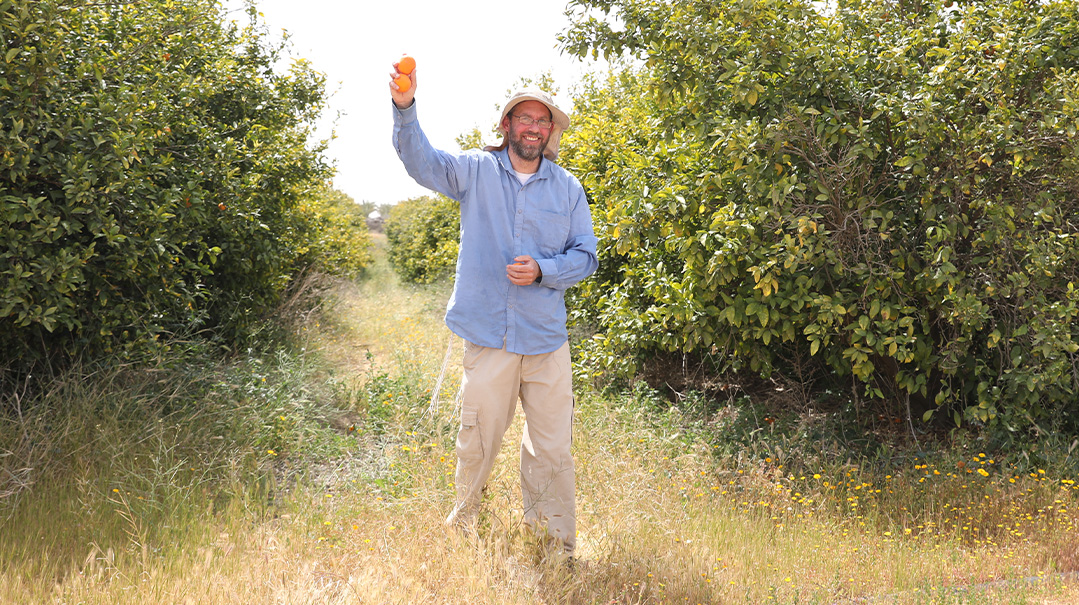
Alon Gottlieb, Talmei Eliyahu
“Hashem talks to you through your business.”
Wake-Up Call
“Kol-mann, you know Steven Kol-mann who sells esrogim in London? I supply him.”
The speaker is Alon Gottlieb, a 40-something religious farmer who grows citrus and avocado for export, and one of the first things I learn while standing in his clementine orchard in Moshav Talmei Eliyahu is that the world really is a small place.
That’s because I do happen to know Mr. Colman — his son is my brother-in-law.
The unlikeliness of this particular encounter brings a shy smile to Alon’s face, and serves as a springboard to his own improbable journey.
“A few years ago, things began to go seriously wrong financially,” he says. “Everything that could go wrong, did.”
Originally from a farming family in the north of Israel, Gottlieb had moved to the Gaza border area in 2005 to join many of those who’d lost their homes in Gush Katif and wanted to start over nearby.
Two years later came shemittah, and Gottlieb — who belongs to the “chardal” or chareidi-leaning part of the national-religious world — followed the widespread practice in his community, which is to use the heter mechirah, a halachically controversial instrument, in which land is sold to non-Jews, thus permitting normal farming in shemittah.
“I did that for the first shemittah in 2007, and then again in 2014, but I wasn’t happy — there was no feeling of shemittah left,” he says. “I worked the same as any other year.”
The heter mechirah that Alon used for his avocado plantations wasn’t the only approach that didn’t feel right.
“I was exporting esrogim to America and England, and so to grow things in shemittah, I used Otzar Beis Din,” he continues, referring to the mainstream practice in which the beis din take control of a field, employing the farmer on the public’s behalf to grow the crop.
Although the latter is perfectly acceptable in the halachic sense, to Alon, it didn’t feel right.
“Esrogim need a lot of work, otherwise they won’t sell. I just felt like a Shabbos goy, working the fields like normal.”
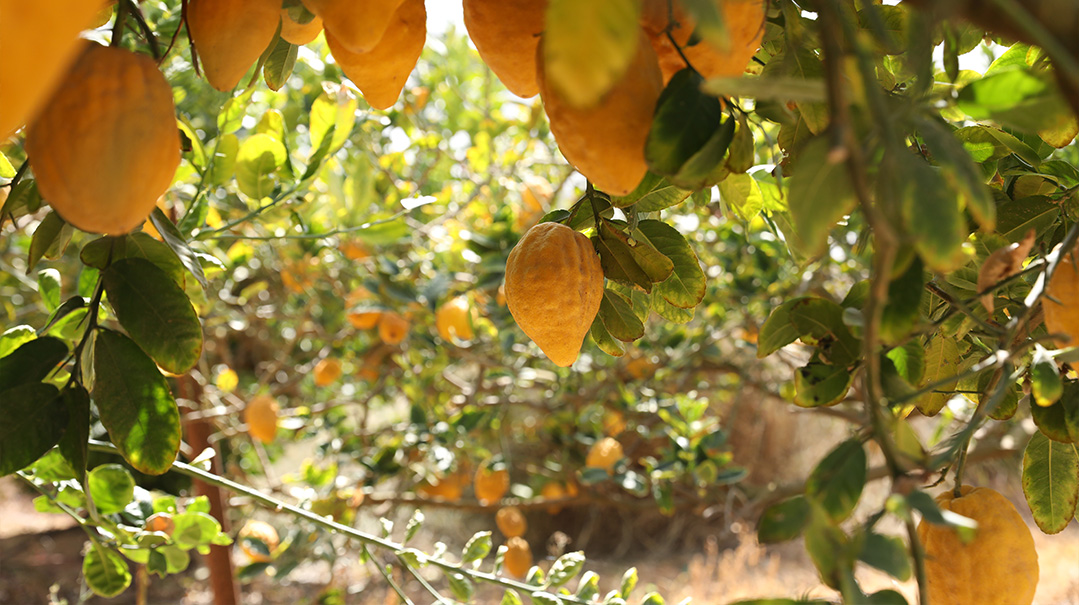
Turning Point
It took a wake-up call for Alon Gottlieb to change direction.
Fifteen years after the Gush Katif refugees began plowing the desolate lands outside the Gaza Strip, the desert was literally blooming.
To the surprise of everyone — including local Arabs, whose agricultural returns had been poor — the sandy dunes in the area turned out to be perfect for growing everything from cherry tomatoes to oranges. Carrots and potatoes grown in this northwest corner of the Negev were taking Europe by storm.
With business booming, Alon — who was in a partnership with his father and brother — decided that he could afford his own packaging plant.
He gestures to the building, on the edge of the small moshav a few hundred meters away from our position in the clementine groves. “It was all ready, complete with the machinery. The fruit was harvested. All we needed in order to begin operating was a permit from the Agriculture Ministry.”
Then, disaster struck in the form of a torrential downpour — a rare occurrence in this desert region.
“The inspectors turned up and saw pools of water everywhere. That was the end of the story — no permit.”
It was only the first blow for the Gottlieb farm; others followed swiftly. Alon locked in a deal on his crop with a supplier, but after he’d harvested it, the firm wouldn’t honor it. It was another big loss.
“I got to the stage where I owed the bank a million shekels, and my checks were on the verge of bouncing. My father had to threaten to close his own account if they didn’t give me room to work things out.”
At that point, the penny dropped.
“I turned to Hashem and said, ‘I understand what’s going on here. Let’s make a deal; there’ll be no more games. Just get me out of this hole!’ ”
Bounty Strikes
Alon Gottlieb pauses his story to move into the shade of the clementine trees, which stand unkempt after six months’ rest.
He picks a couple of hefker fruit, and offers them. The sweet fragrance joins the scent of the trees that already have tiny buds — the first signs of next year’s crop.
“That year,” he continues his tale, “I sold and sold and sold as never before. It was like a dream. The trees groaned under enormous amounts of fruit — there were hundreds of tons. All the esrogim that I picked were Grade A.”
Focused on paying off his debts, he worked nonstop harvesting and shipping a stream of orders. Having moved to Yerushalayim for health reasons, because a family member had trouble in the sandy air of the Negev, that meant days of sleeping by his orchards.
Gottlieb only became aware of the scale of his success when things had quieted down.
“Not only are we out of the red,” he told his wife, “you can go and look for an apartment of our own in Yerushalayim.”
At that point he told his family about the plan to keep shemittah. His father, who had always relied on the land sale, was against the idea.
There was an ideological element to that resistance. In some circles, relying on the heter mechirah is seen as a tenet of religious Zionism, because it supports Jewish agriculture.
But mostly, opposition to the move was practical. Israeli agriculture operates on narrow margins, competing with growers in Turkey and Morocco who have overheads far lower than Israel.
“How can a person throw away his income for a whole year?” said the rest of the family.
But as Rosh Hashanah 2021 approached, Alon stuck to his guns.
“It’s my truth,” he explained to those around him. “Hashem talks to you through your business.”
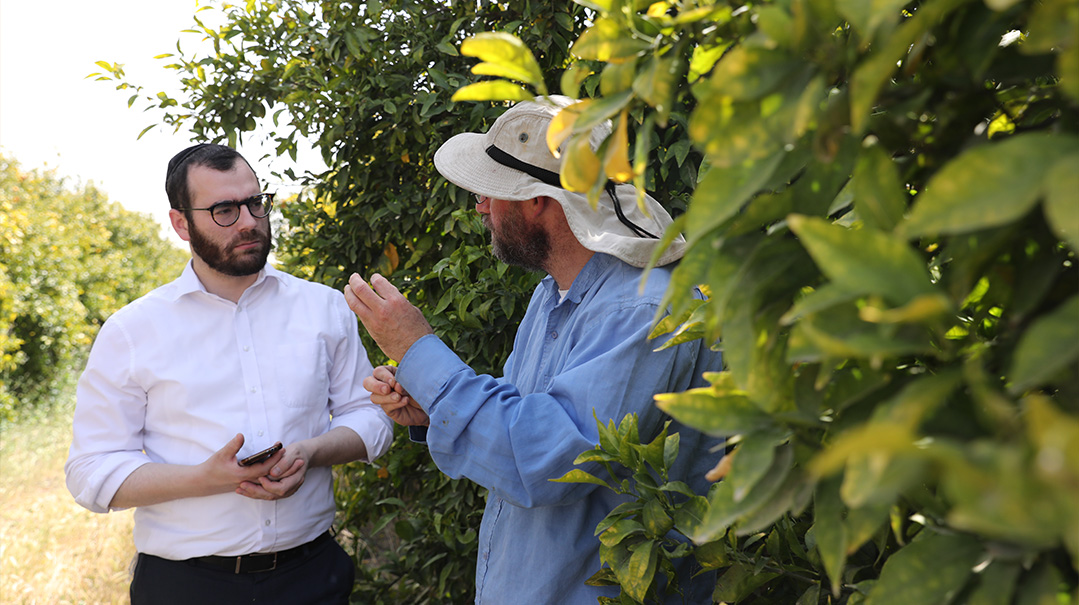
Mishpacha’s reporter examines Alon’s overgrown fields. “A farmer lives through bad years with the hope that next year will be better, but that’s a long way off”
“It’s Difficult to See”
I’ve never stepped foot before in an esrog orchard, but even to my uninitiated eyes, the place is a mess. The trees are overgrown, and the esrogim themselves are in bad shape — some covered with fungus, others beaten up.
“To tell you the truth,” says Alon, “it’s really difficult to be here, to see the torn mosquito nets, the overgrown trees and not to do anything. That’s why I don’t come here often.”
Six months into shemittah, reality is biting. The initial glow of the fresh undertaking is gone, and the end is nowhere in sight. And with zero income, costs still remain.
“People don’t understand that for a fruit grower, we still need to pay a fortune in water just to keep the trees alive,” he says.
“A farmer lives through bad years with the hope that next will be better, but that’s a long way off at the moment. The bank is ringing to ask why all income has suddenly disappeared. And I have no idea if my customers will wait for me until next year.”
It’s only the genuine smile that explains that Alon Gottlieb is merely processing his reality, not complaining. He’s at peace with his choice.
“I’m now deep into Bava Kamma and Shabbos, and spend most of the time with my chavrusa,” he says in his modest way, as we exit the orchards to where the cars are getting a coating of Negev dust.
“I’ve worked nonstop all these years, and now it’s time to rest.”
A Higher Power
As Talmei Eliyahu recedes into the rearview mirror, the road ahead, even in the early afternoon, is notably traffic-free.
This part of the country isn’t quite Saudi Arabia’s vast “Empty Quarter.” But stopping to snap a picture of the beautifully-muraled bomb shelters dotted around runs no risk of road rage from other drivers, simply because there aren’t that many around.
That leaves plenty of time to ponder the origins of today’s road journey in a long-forgotten press release.
A decade ago, the Israel Democracy Institute, a Jerusalem-based think tank, released a survey about faith in Israel that was astounding, in the real sense of the word.
According to the report, 80 percent of Israeli Jews — including the 46 percent who defined themselves as secular — said that they believed in G-d. Further, 67 percent believed in the concept of the Chosen People, and 65 percent believed in the Divine origin of the mitzvos.
For context, in Britain, one of the world’s most secular countries, only 27 percent of people professed belief in a G-d, according to a recent survey.
Even in America, where four out of five people say that they believe in G-d, scratch the surface and results are less impressive. Ask about the Biblical G-d and the percentage is somewhere in the mid-50s.
The 2012 report proved a bombshell. As usual, it was the staunchly secular Ha’aretz newspaper that crystallized the situation best.
“The secular majority is no more,” read their headline. “This is no longer popular veneration of traditional customs, but of belief.
“Three out of four Israelis are not atheists,” concluded the paper in shock.
Fifteen years of interactions with Israelis such as the man in central Tel Aviv who I saw making Kiddush while the TV played in the background, confirms Ha’aretz’s worst fears.
Israel in the 21st century is becoming the Land of Faith.
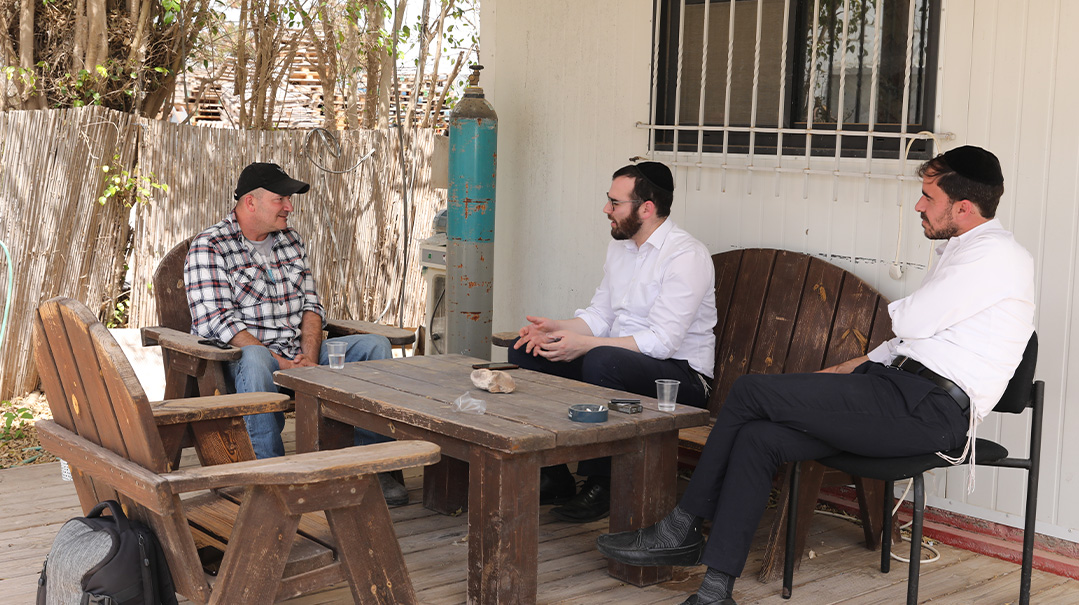
Amit Abutbul, Naveh
“There’s no such thing as a farmer who doesn’t believe.”
Turning Point
Salt of the earth is one way to describe bluff, honest Amit Abutbul. As he sits smoking in the shadow of his wooden cabin office in Moshav Naveh, Marlboro Man is another.
But this year, the barrel-chested, check-shirted farmer deserves another title: star of Keren Hashviis, the organization that raises enormous sums to provide a shemittah stipend for farmers.
A good-sized Israeli farm might be 50 dunams, or 50,000 square meters. But with over 2,000 dunams of cultivated land, Abutbul is one of the largest growers in the country’s south. There was no way that he was going to sign on to keep shemittah.
Until, in an inexplicable volte-face, he took the plunge.
“One day, I got a phone call from Yona,” he says gesturing to Yona Bokovza, the Keren Hashviis representative who knows the South’s shemittah map like the back of his hand. “He wanted to come past to talk.”
As his frequent references to “Briskers” and “the Eidah” give away, this traditional farmer with a Moroccan background knows the chareidi world well. For the past 15 years, he’s been a major supplier of bug-free lettuce, greens, and sweet corn to the chareidi market under the Alei Besor label.
So, Amit Abutbul knew exactly what was up for discussion, and after talking to his accountant, he said no.
“He told me that there was no way that I could afford it — my direct loss would be about 7 million shekels. I employ 60 workers. What would I do with all of them?”
Amit Abutbul is a man who knows his own mind, but his visitor had the last word.
“A few weeks later, I got a call from Yona asking if Bnei Brak mayor Rabbi Avraham Rubinstein could come to visit. Because of his stature, I agreed, although I made clear that I wouldn’t change my mind.”
Not long after, a car pulled up, and the long-bearded, frock-coat-clad Rabbi Rubenstein — every inch the dignified rosh kollel he once was — emerged and greeted Abutbul.
The pair sat down and began to talk. Rabbi Rubenstein spoke about the great opportunity at hand, what a merit it would be for his host’s family.
It wasn’t just Abutbul’s own lands that were at stake — as a local success story, others in the area could be persuaded to follow his lead as well.
But the visitor got nowhere. His explanations were met with polite rejection. After about two hours, the conversation ended. Rabbi Rubenstein turned to leave, his face downcast at the failure.
Then the incredible happened — the farmer changed his mind.
He turned to his guest, who was already on his way out, and said, “I’m ready to keep shemittah.”
Both Rabbi Rubenstein and Yona Bokovza were lost for words.
In explanation for the sudden about-face, Abutbul says something that sounds scarcely believable.
“I saw how sad he was, and I thought to myself, ‘If it means so much to these important people that I keep shemittah, I can’t disappoint them.’ ”
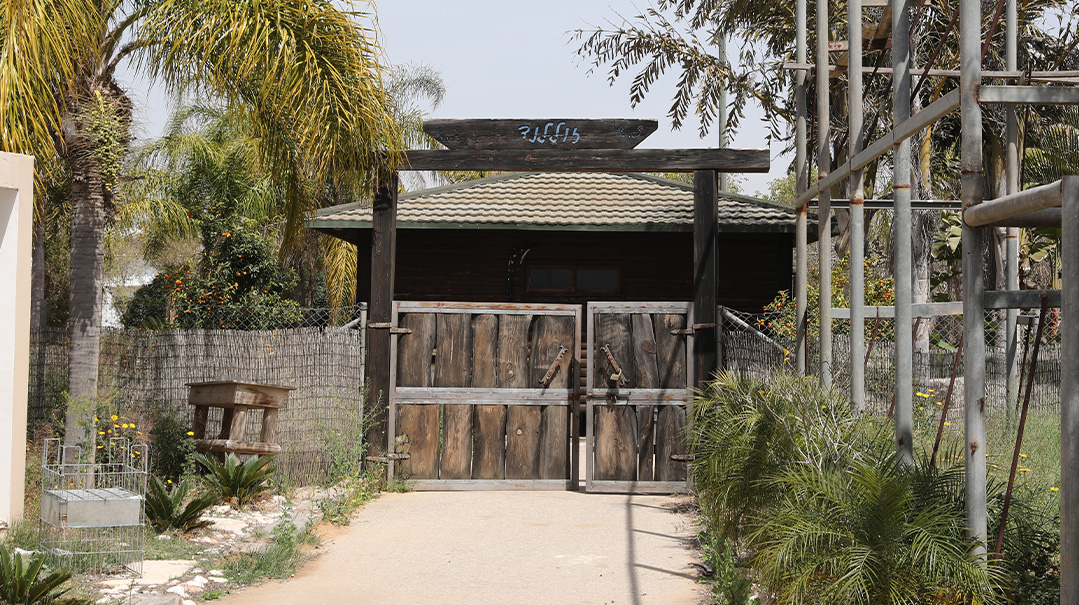
“I’ve Seen Miracles”
Amit Abutbul adjusts his baseball cap and pauses with his story. He may have laid off most of his 60 employees, but there’s still something of the grand seigneur about the way that Abutbul deals with someone who’s come to make a delivery.
“It’s a consignment of hefker onions for people to take,” he say, nodding to the truck that has reversed alongside us.
Abutbul’s adult son, a slighter version of the father, but with the same garb of jeans and boots, comes up to say hello.
By this stage of shemittah, he’s used to the pilgrimage of religious people there to congratulate his father. His bare head indicates that the family are on the non-practicing end of Israel’s traditional spectrum.
That underlines the question around the family’s adoption of shemittah.
“I always wanted to keep it properly,” Amit explains, and then points upwards. “I’ve never been close to a rabbi — I respect rabbanim, from a distance.
“But I’ve seen miracles in my life.”
One such came in the previous shemittah in 2014. Abutbul had paid for 400 dunams worth of yevul nochri — vegetables grown by an Arab farmer on Arab owned land. The mashgiach from the Eidah Hachareidis was ready to give a hechsher to the harvest, when a problem emerged.
One part of the land, according to the Eidah’s research, was subject to an ownership dispute. As such, the state had moved in to take a custodial role — which meant that the produce was considered grown on Jewish-owned land in shemittah.
“I told the Eidah, ‘No problem, I’ll go to the Israel Lands Administration to check exactly which plot is problematic and then we’ll fence that off.’ ”
But things didn’t work out. The Tel Aviv–headquartered ILA agreed that there was a problem, but couldn’t isolate which fields it referred to.
The determined farmer didn’t give up. Next, he brought the local sheikhs from the Shomron where the plot was, to the Eidah Hachareidis offices in the Zupnick building in Jerusalem’s Rechov Strauss.
“I remember all the kids sitting round watching them come in,” he smiles. “But it was no use — the produce worth millions of shekels was a dead loss.”
At that point, one of Abutbul’s workers stepped in. Aharon, a truck driver, suggested that he go to Rav Yoram Abergel ztz”l, a tzaddik from Netivot famous across Israel’s south.
With nothing to lose, Abutbul went to the rabbi, who closed his eyes for several moments in concentration and then said, “May all the gezeirot become null.”
“I thought to myself, ‘Very nice, but I need my land!’ ”
Mere hours later, he had his wish.
“I got a call from the Eidah: ‘We’ve located the land — you can sell the crop.’”
Rav Chaim’s Promise
That brand of simple faith typical of vast numbers of Israelis of Sephardic background is the backdrop to the finale of Amit Abutbul’s story.
It took the Bnei Brak mayor a moment to recover from the surprise of his host’s announcement, but then he went back to his car and emerged with a sefer in hand.
It was a copy of Rav Chaim Kanievsky’s work on Maseches Sheviis — the tractate that deals with shemittah. The signed dedication read: “Amit Abutbul, who has undertaken to keep shemittah… may your property increase greatly.”
Just over six months since that strange encounter, and two weeks after the writer of those wishes passed on, the weather-beaten farmer cradles the sefer reverentially, as he recalls the denouement.
“Rabbi Rubenstein said that when he left Bnei Brak, he knew that I wasn’t intending to keep shemittah. But Rav Chaim had written that I was going to, so he was sure it would happen. He just had to find out how things were going to work out.”
Farmer’s Faith
If it weren’t for the manifests pinned to the wall in Thai — the language of many of Israel’s migrant farmhands — recording the last deliveries before the plant shut down before Rosh Hashanah, the Alei Besor processing facility could be a machinery showroom.
In a regular year, the large facility is a plant-to-package conveyor belt. Vast quantities of vegetables grow on the adjacent flatlands are brought in via the loading bays.
Then they run the gauntlet of sorting, soaking, washing, drying, cutting, packaging, and labeling machines before they’re boxed for delivery to consumers across the country.
But the German-made machinery stands, gleaming and idle, in the spotless factory, testament both to Abutbul’s cleanliness and idealism.
“Of course, it’s difficult to come and see this place empty,” he says, “but even after six months, I’m at peace. Farming is very intense, round-the-clock. This year is time for my nefesh.”
As an industrial-scale grower, this particular farmer isn’t likely to starve on his sabbatical. But the quiet contentment that he exudes seems to go beyond financial questions.
“There’s no such thing as a farmer who doesn’t believe,” he explains his leap of faith. “You put something in the ground and have no idea what will come out.”
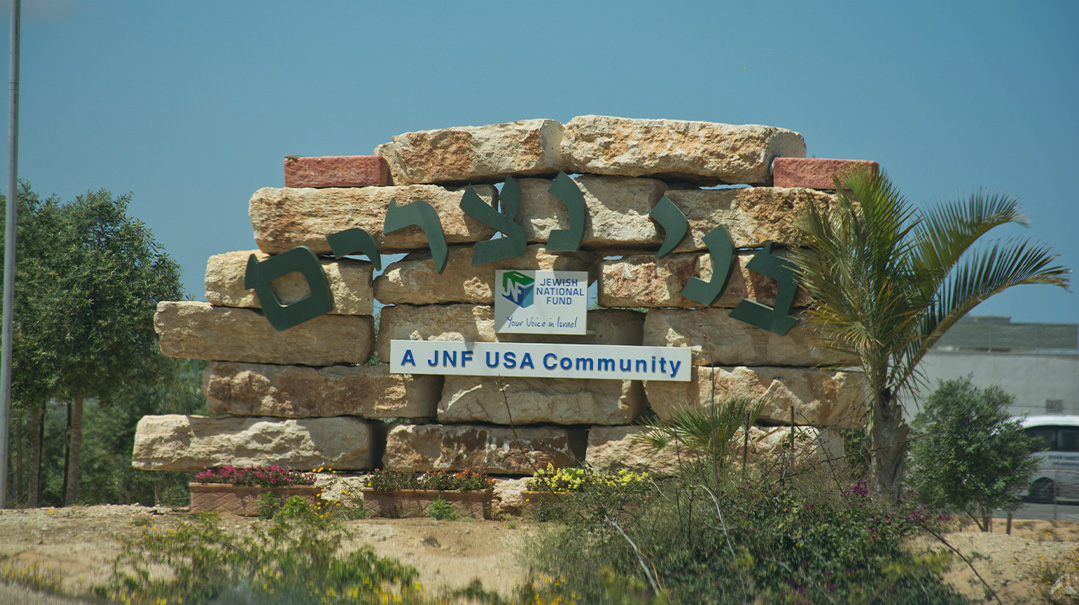
Sword and Plowshare
Forty-nine kilometers and 66 years away from Abutbul’s Moshav Naveh, in Kibbutz Nahal Oz, bordering the northern Gaza Strip, Israel’s version of the Gettysburg Address entered the history books.
The year was 1956, and the young state was beset by fedayeen, Egyptian-sponsored Palestinian guerillas who entered Israel almost at will to murder and maim.
Ro’i Rotberg was the kibbutz’s 21-year-old security officer. One morning, as Lag B’omer approached, he set out on horseback to order Arab intruders off the village’s land.
Instead, he was ambushed, killed, and mutilated by a group of Palestinians and Egyptians, who dragged his body across to Gaza.
Rotberg’s death shook the young state, and brought Moshe Dayan to the kibbutz to deliver a eulogy that was a lyrical expression of secular Zionist beliefs.
“Have we forgotten that this group of young people dwelling at Nahal Oz is bearing the heavy gates of Gaza on its shoulders?” asked the one-eyed war hero.
“We are a generation that settles the land, and without the steel helmet and the cannon’s maw, we will not be able to plant a tree and build a home. Let us not be deterred from seeing the loathing that is inflaming and filling the lives of the hundreds of thousands of Arabs who live around us.
“This is our life’s choice — to be prepared and armed, strong and determined, lest the sword be stricken from our fist and our lives cut down.”
To modern Israeli ears — used to the dovishness of the left wing, which fathered the kibbutz movement — the tone is jarring. It’s hard to remember that it was kibbutzim like Nahal Oz and many others around Gaza who were the thin line holding back the Arab hordes.
Fast-forward six decades, and the kibbutz’s new neighbors highlight the shift from secular belief to religious faith that has transformed the face of Israeli pioneering.
When the 8,000 residents of Gush Katif — who’d built oases of Jewish life in the Death Valley that is the Gaza Strip — were ripped out of their homes by Ariel Sharon in 2005, many of them chose to stay in the area.
As the Palestinians destroyed the greenhouses that had made Gush Katif a byword for agricultural innovation — the very greenhouses gifted to them by naïve foreign donors — the uprooted farmers planned their future on the other side of the border fence.
In the sands of the Chalutza region bordering Egypt and Gaza, new red-roofed moshavim have sprouted like the cherry tomatoes grown in the greenhouses all around.
The local building boom is a symbol of generational change.
Moshe Dayan’s secular pioneers have vanished; the old kibbutzim are still here, but no one builds new stockade-and-tower settlements while quoting Labor Zionism anymore.
Yet determined to settle every corner of the Holy Land, Gush Katif’s religious farmers — such as those in Bnei Netzarim, my next stop — have picked up both the sword and the plow to defend Israel’s borders again.
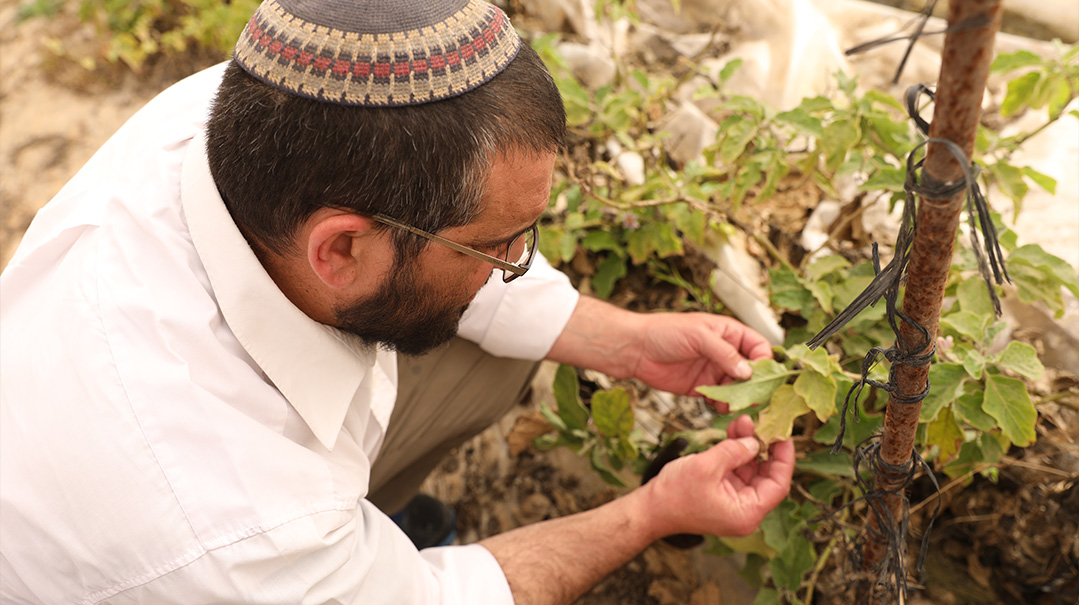
Sharon Cohen, Bnei Netzarim
“It should be a shemittah for Hashem, not merely to change jobs.”
Left Field
Sharon Cohen’s greenhouses are a memorial to crops bygone.
Small, stunted eggplants grow randomly where rain has penetrated the plastic roof. Trailing black cords indicate the framework over which cherry tomatoes once grew.
“If you’re not a farmer,” he says, bending down to indicate a plant that has taken root against the odds, “this looks healthy. To me, this is a sickly green.”
The 43-year-old’s white shirt isn’t his normal garb. It’s Shabbos attire for a year of Shabbos, which he’s spending in the beis medrash in Bnei Netzarim, a lusty stone’s throw from Egypt.
As its name indicates, the village is the successor to Netzarim, a moshav that was built southwest of Gaza City in 1972.
For Sharon Cohen, the “expulsion” — as many label the Gaza retreat — wasn’t even the first time the government had driven him out of his home.
Born in 1979, his parents had lived in Yamit, an Israeli town in the Sinai Peninsula that was destroyed when Menachem Begin returned the area to Egypt in 1982.
So, when the Sharon government destroyed his home in the flourishing community of Netzarim — a stronghold of religious Zionism — it was obvious to him that he was going to stay on Israel’s frontier.
Netzarim, after all, had become a central symbol of faith to the bitter end. The very last yishuv to be evacuated, it was there that famously, residents planted seedlings and poured concrete for a new house on the very day that the village was destroyed.
That background explains Sharon’s fiercely ideological adoption of shemittah this year. Of all the farmers we meet, he seems most concerned with the hashkafic context of his choice.
Not for him tales of Heavenly messages or Bnei Brak mayors — he is following his rav into an extremely precarious future while gripping his faith like a walking stick.
“Bnei Netzarim is only here because of Rav Tzvi Tau,” he says referring to the rosh yeshivah of Har Hamor, a major force within the chareidi-Zionist wing of the national-religious world. “Immediately after the expulsion, he said that we should come here instead of moving to developed places elsewhere in Israel.”
So, when his rosh yeshivah urged him to keep the full shemittah instead of heter mechirah, the farmer agreed, and then tried to figure out how. “He said, ‘It’s time for you to move up a level and create a kiddush Hashem.’ ”
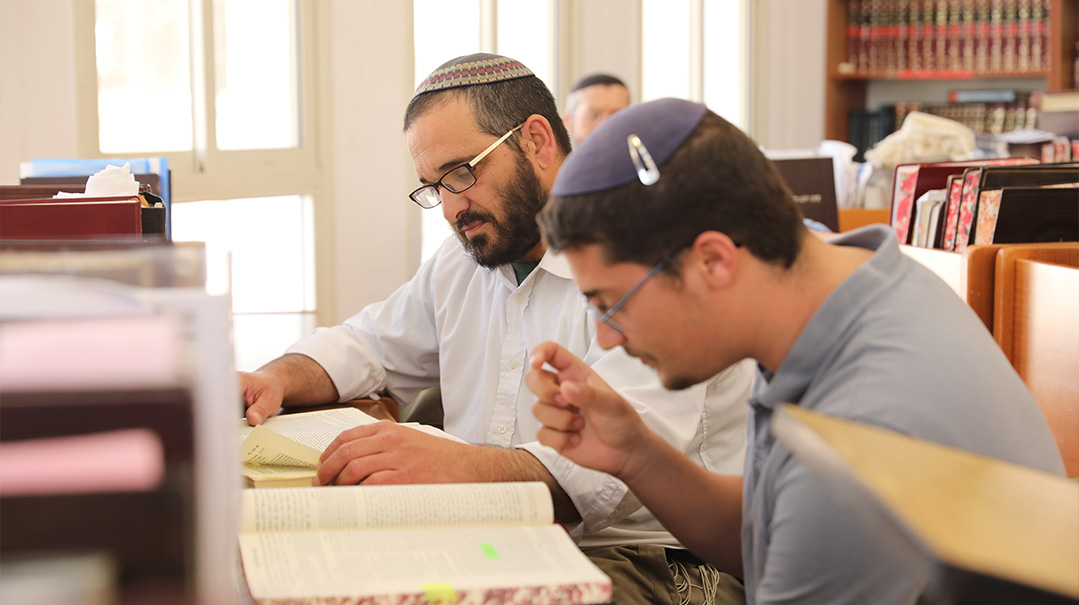
Prayers and Tears
In Sharon Cohen’s case, that hasn’t come easy. Farming didn’t run in the family, nor was it his main occupation after he left yeshivah and kollel, where he spent some years.
But good with his hands, he discovered a knack for growing things while tending some trees.
He took a business partner and opened his own farming business, expanding to dozens of dunams and securing a contract to supply ingredients for school meals to the Education Ministry.
“Only a farmer can understand what type of connection we develop to the land,” he says with characteristic passion. “It’s our home.”
It’s with the same candor that he begins to discuss the very tough reality that keeping shemittah has forced on him. He’s heavily in debt and six months in, he honestly doesn’t know how he will keep his head above water.
“I normally take home 21,000 shekels a month,” he explains. That sum, comfortable by Israeli standards, has vanished.
There’s a widespread misperception that Keren Hashviis — whose signs adorn Sharon’s greenhouses — picks up the full tab for farmers. In fact, says Yona Bokovza, few even receive 30 percent of their income. The stipends are meant to stop their businesses from failing totally.
“My wife now holds down three jobs, because we want to do shemittah properly,” says Sharon Cohen. “I want to be able to sit and learn. It says it should be a shemittah for Hashem, not merely to change jobs.
“I honestly don’t know how things will turn out,” he says.
Reverting to hashkafah, it’s as if he finds himself strengthened by the familiar concepts. “But unlike Yetzias Mitzrayim from over there” — gesturing to Egypt a few hundred meters away — “Hashem only wants us to do little by little, not with open miracles.”
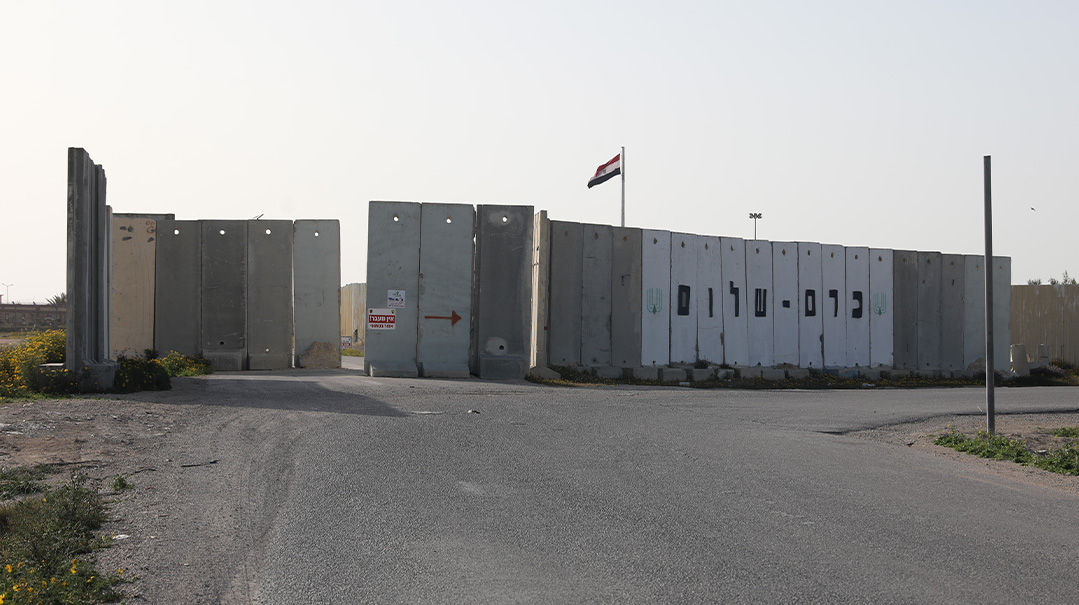
Boom Box
It’s late afternoon when I head out of Bnei Netzarim toward a geopolitical landmark. The sun sends a golden glow over the bucolic-sounding Kerem Shalom, a deceptive name for the main crossing point to Gaza.
The line of trucks waiting to enter is a reminder of just how twisted is the criticism of Israel’s Gaza policy. About 400 trucks transit each day carrying everything from fuel to food and medicine. Yet in wartime, the terminal comes under fire from the very people whom Israelis are endangering themselves to feed.
Driving north along the length of the Strip toward Sderot, there are further reminders of the fact that Israel, alone among the nations of the world, is held to unique standards — expected to negotiate away its land even as its enemies prepare to attack.
High in the air is a blimp, packed with sensors to monitor the “militants,” to use the sanitized media phrase. At various points along the smart wall around Gaza, remote-controlled machine guns are emplaced, to deter potential attackers from approaching.
The closer you get to Gaza, the more often you hear booms and thumps — the sound of the large-scale firing drills that Hamas and Islamic Jihad stage as they hone their tactics by firing into the sea.
It’s a grim soundtrack that could be set to the words of the Haggadah that ring so true here: “In every generation, omdim aleinu l’chaloseinu.”
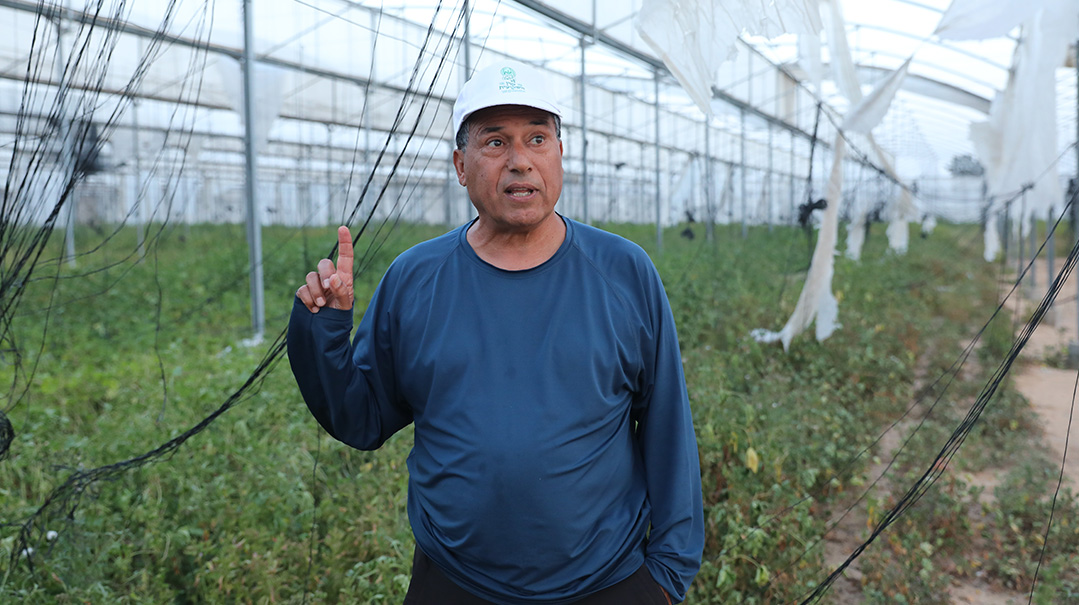
Shaikeh Shaked, Netiv Ha’asarah
“You think that shemittah belongs to religious people?”
Help on High
Standing next to his pickup truck in the entrance to Netiv Ha’asarah, a moshav on Gaza’s northern border, Shaikeh Shaked looks like the village headman, in a very literal sense.
Not only is he the 70-year-old farmer responsible for different agricultural developments whom others in the industry consult.
He’s also the proud wearer of a Keren Hashviis cap, advertising the fact that he’s the only farmer in this moshav to keep shemittah.
His story demonstrates how when you live at the border, emunah is really the only option — even if you’re secular.
“See the village a mile away over the fence? That’s Beit Lahya in Gaza. Now, look at this black stain on the asphalt,” he continues. “That’s where Hamas fired a Kornet anti-tank missile and destroyed an IDF jeep ten months ago in the last Gaza war.”
The blackened brush all around tells the other half of a story that was caught by TV cameras. Hamas fired tens of mortar shells at the area to prevent the wounded soldiers’ evacuation.
Shaikeh, a former IDF commander who served as governor of Rafiah, a city in the southern Gaza Strip, lives almost as close to Gaza as it’s possible to be.
Between the concrete border wall and his house is only one other — his daughter’s, which practically nestles up to the barrier.
In the last round of fighting, shells fell all around their homes. At point-blank range, the Iron Dome is useless.
What type of insurance, I wonder, do you need to live there?
“From up there,” he responds, pointing heavenward.
Pilgrim Father
That’s a very useful jump-off point to ask the inevitable question: What brought this man to keep shemittah?
While his parents were from Aden, southern Yemen, Shaikeh explains, Adani Jews are not considered Teimanim. A good, warmhearted, traditional Jew, certainly, but not more.
“I’m 70 years old now,” he says simply, although his smooth olive skin makes him look two decades younger. “I’ve been a farmer for 45 years, and have always wanted to do it properly. It’s like a Muslim, they need to go on hajj, a pilgrimage to Mecca once in their lifetime. Who knows if I’ll be able to keep it next year?”
The answer is only vaguely satisfying, especially because he admits to substantial losses that he hadn’t accounted for, such as the ongoing arnona land tax and tractor licenses that must be maintained.
But I leave off the questioning while looking around his greenhouses.
The structures look new, and in excellent working order — all except the plastic sheeting on top. Part of that is because he’s not doing any maintenance at all, and part is due to bits of rockets floating down.
“When a rocket is fired at Ashkelon or Ashdod, the Iron Dome batteries there intercept it over ‘open space’ — which could be one of the moshavim around here. But who can we claim the 1,000 shekels for the roofing from?”
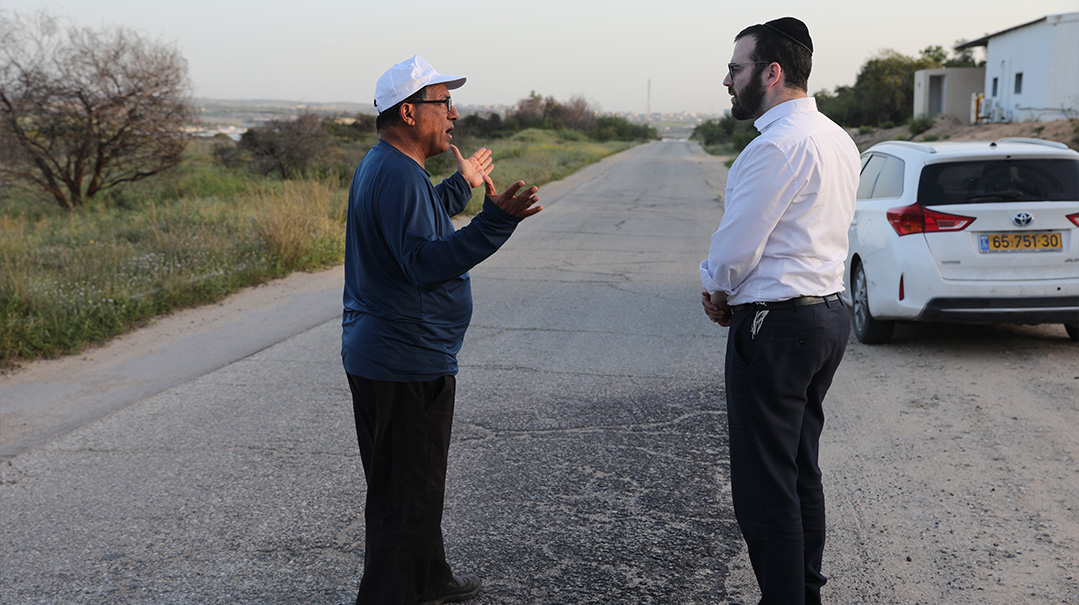
Holy Ground
The sun is fast slipping down to the west, which, in that part of the world, means into the Mediterranean.
Shaikeh Shaked stands by respectfully as we daven an unusually serene Minchah in the greenhouse with its carpet of weeds.
You don’t need to be Rav Levi Yitzchak of Berditchev to grasp the sense of elevation.
In this unlikely place — a moshav where the sanctity of shemittah has never before penetrated — this Jew has transformed a vegetable patch into something holy.
Like Ne’ilah on Yom Kippur, the sky is darkening, and Shaikeh’s choice feels partially unexplained.
Signs from the heavens and following rabbanim is one thing. But why are Jews like Shaikeh prepared to give up so much? What type of faith is bubbling to the surface of this strife-beset land?
I press him on the issue, pointing out that there are easier entry points to Jewish practice than a hole in the wallet.
His patience snaps.
“You think that shemittah, tefillin, and mezuzah only belong to you, religious people?” he says sharply, speaking for millions of outwardly secular Israelis in this Land of Faith.
“They’re ours too.”
(Originally featured in Mishpacha, Issue 907)
Oops! We could not locate your form.

